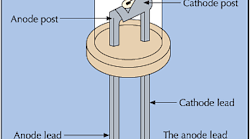First used as status and indicator lamps, and more recently in under-shelf illumination, accent lighting, and directional marking applications, high-brightness LEDs have emerged within the last six years. But only recently have they been seriously looked upon as a feasible option in general purpose lighting applications. Before you recommend or install this type of lighting system, you should understand the basic technology upon which these devices are based.
Light-emitting diodes (LEDs) are solid-state devices that convert electric energy directly into light of a single color. Because they employ “cold” light generation technology, in which most of the energy is delivered in the visible spectrum, LEDs don't waste energy in the form of non-light producing heat. In comparison, most of the energy in an incandescent lamp is in the infrared (or non-visible) portion of the spectrum. As a result, both fluorescent and HID lamps produce a great deal of heat. In addition to producing cold light, LEDs:
-
Can be powered from a portable battery pack or even a solar array.
-
Can be integrated into a control system.
-
Are small in size and resistant to vibration and shock.
-
Have a very fast “on-time” (60 nsec vs 10 msec for an incandescent lamp).
-
Have good color resolution and present low, or no, shock hazard.
The centerpiece of a typical LED is a diode that is chip-mounted in a reflector cup and held in place by a mild steel lead frame connected to a pair of electrical wires. The entire arrangement is then encapsulated in epoxy. The diode chip is generally about 0.25 mm square. When current flows across the junction of two different materials, light is produced from within the solid crystal chip. The shape, or width, of the emitted light beam is determined by a variety of factors: the shape of the reflector cup, the size of the LED chip, the shape of the epoxy lens and the distance between the LED chip and the epoxy lens. The composition of the materials determines the wavelength and color of light. In addition to visible wavelengths, LEDs are also available in infrared wavelengths, from 830 nm to 940 nm.
The definition of “life” varies from industry to industry. The useful life for a semiconductor is defined as the calculated time for the light level to decline to 50% of its original value. For the lighting industry, the average life of a particular lamp type is the point where 50% of the lamps in a representative group have burned out. The life of an LED depends on its packaging configuration, drive current, and operating environment. A high ambient temperature greatly shortens an LED's life.
Additionally, LEDs now cover the entire light spectrum, including red, orange, yellow, green, blue, and white. Although colored light is useful for more creative installations, white light remains the holy grail of LED technology. Until a true white is possible, researchers have developed three ways to deliver it:
-
Blend the beams. This technique involves mixing the light from multiple single-color devices. (Typically red, blue, and green.) Adjusting the beams' relative intensity yields the desired color.
-
Provide a phosphor coating. When energized photons from a blue LED strike a phosphor coating, it will emit light as a mixture of wavelengths to produce a white color.
-
Create a light sandwich. Blue light from one LED device elicits orange light from an adjacent layer of a different material. The complementary colors mix to produce white. Of the three methods, the phosphor approach appears to be the most promising technology.
Another shortcoming of early LED designs was light output, so researchers have been working on several methods for increasing lumens per watt. A new “doping” technique increases light output several times over compared to earlier generations of LEDs. Other methods under development include:
-
Producing larger semiconductors.
-
Passing larger currents with better heat extraction.
-
Designing a different shape for the device.
-
Improving light conversion efficiency.
-
Packaging several LEDs within a single epoxy dome.
One family of LEDs may already be closer to improved light output. Devices with enlarged chips produce more light while maintaining proper heat and current management. These advances allow the units to generate 10 times to 20 times more light than standard indicator lights, making them a practical illumination source for lighting fixtures.
Before LEDs can enter the general illumination market, designers and advocates of the technology must overcome several problems, including the usual obstacles to mainstream market adoption: Industry-accepted standards must be developed and costs must be reduced. But more specific issues remain. Things like lumen-per-watt efficacy and color consistency must be improved, and reliability and lumen maintenance should be addressed. Nevertheless, LEDs are well on their way to becoming a viable lighting alternative.



